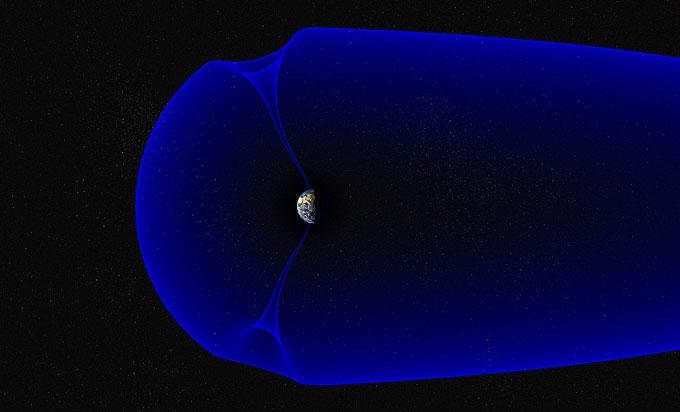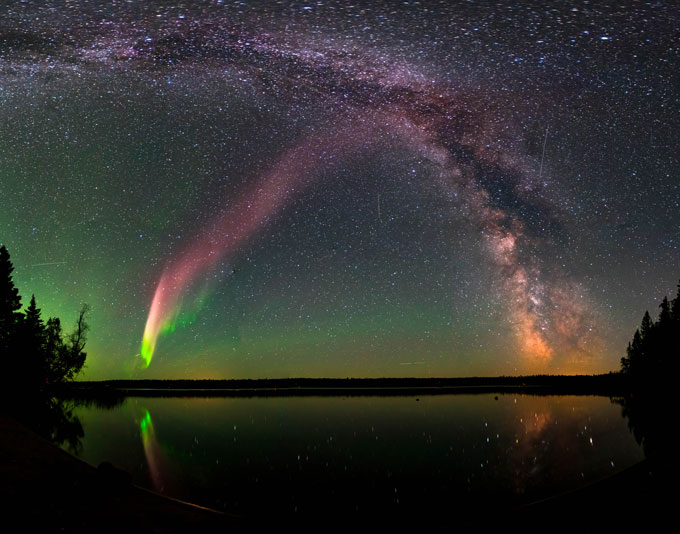Newfound ‘dunes’ is among weirdest of northern lights
This new natural light show joins other auroras, such as black and even pulsating types

There’s a new type of aurora named the “dunes” (horizontal green stripes of light pointing to the left). It is the latest addition to the northern and southern lights.
Pirjo Koski
Share this:
- Share via email (Opens in new window) Email
- Click to share on Facebook (Opens in new window) Facebook
- Click to share on X (Opens in new window) X
- Click to share on Pinterest (Opens in new window) Pinterest
- Click to share on Reddit (Opens in new window) Reddit
- Share to Google Classroom (Opens in new window) Google Classroom
- Click to print (Opens in new window) Print
Sky watchers have spotted a new jewel in the crown of northern lights. These are the natural light displays that shimmer over the top of the world.
The new display is a rare, faint phenomenon that citizen scientists have dubbed the “dunes.” These are unlike other types of auroras. These natural light displays are often called northern lights or southern lights (depending on the hemisphere). They often hang in the sky like luminous curtains. But the dunes appear as green bands. They run parallel to the ground and point toward the equator. Researchers described the dunes online January 28 in AGU Advances.
People across Finland and Sweden took digital photos of the weird light display on October 7, 2018. Later, researchers looked at these pictures, snapped from different locations. The scientists then determined the position of a set of the dunes stretching across the sky from western Sweden to western Finland. The photos also revealed that the dunes had hovered about 100 kilometers (62 miles) above the ground.
“Aurorae are like fingerprints in the sky,” says Minna Palmroth. She is a space physicist at the University of Helsinki in Finland. She helped with the new study. Auroras (also called aurorae) usually appear when electrons rain into the atmosphere from the magnetosphere — a magnetic bubble surrounding Earth. Those electrons set oxygen and nitrogen gas aglow. Specific features of those electron–gas interactions give each type of aurora its unique flare.
The dunes aurora
The dunes aurora has unusual stripes. Palmroth and her colleagues suspect that the stripes could arise from atmospheric waves — ripples of gas in the atmosphere. The crests of those waves are denser regions of the air. That’s where air molecules are packed together more tightly. In such spots, there would be more oxygen for cascading electrons to excite into glowing green.
Such atmospheric waves could cause the broad, uniform structure of the dunes, says Gerard Fasel, who was not involved in the work. He is a physicist at Pepperdine University in Malibu, Calif. To link these atmospheric waves to the dunes’ structure will take work, he says. Researchers will need to collect more observations of this type of aurora. They also will need to try to simulate those features in a computer model. That could help confirm what gives the dunes their special structure or shape, he says.
The dunes are only the latest in a long line of auroral oddities. Collectively auroras are considered one of the natural wonders of the world. And researchers and citizen scientists have been uncovering a rich diversity in these natural light shows.
Here are some of the more obscure auroras of the northern and southern hemispheres.
Pulsating auroras
These light shows can span hundreds of kilometers (miles) across the sky, rhythmically brightening and dimming. “They can actually happen most nights,” says Allison Jaynes. She is a space physicist at the University of Iowa in Iowa City. Cameras can pick them up fairly easily, she notes. “But you can’t see them very well just with your eyes,”
These pulsating auroras also “tend to happen after midnight,” she adds, and continue “into the morning hours.” People tend to miss these light shows because most are asleep while they’re blinking away.
The flashes of light in these auroras are caused by ripples in Earth’s magnetosphere. These ripples are called chorus emissions. These chorus waves affect electrons in the magnetosphere sort of like ocean waves. Ocean waves periodically deposit foam on a beach. Similarly, chorus waves periodically push bunches of electrons down into the lower atmosphere. And that creates a flickering auroral glow.
Cusp aurora
Unlike most well-known auroras, the cusp type can be seen midday. But only, that is, if you’re far enough north or south that it’s dark around noon. The Norwegian archipelago of Svalbard “is one of the few land masses where you can see cusp aurorae,” says Elizabeth MacDonald. She is a space physicist. She works at NASA’s Goddard Space Flight Center in Greenbelt, Md. She also founded the aurora-tracking citizen science project Aurorasaurus.

Cusp auroras are named for the polar sites where Earth’s magnetic field lines bend inward. Those magnetic field lines create funnel-shaped holes in the magnetosphere. As the solar wind funnels through the cusp, it creates the auroras. (The solar wind consists of charged particles released from the upper atmosphere of the sun.)
Solar wind particles that travel through the cusp move directly into Earth’s atmosphere from outside the planet’s magnetic shield. This is a different source of auroras than those that sometimes light up the night sky. Those night lights are instead generated by electrons raining down on the atmosphere from inside the magnetosphere.
Solar wind particles that enter through the cusp generally aren’t as energetic as the electrons that come from inside Earth’s magnetic bubble. So the excited oxygen atoms that make up cusp auroras only occur at very high altitudes. As a result, they glow red. That’s unlike lower-altitude oxygen molecules that glow green.
STEVE
Like the dunes, the unusual airglow STEVE was named by citizen scientists. This light show also tends to shimmer farther from the poles than typical auroras. It appears as a mauve smear from east to west. And sometimes it contains a so-called picket fence of vertical green stripes.

The green stripes are caused when a downpour of electrons excites oxygen atoms. The mauve streak is harder to account for. Scientists think it’s the signature of a plasma stream. This stream likely heats atmospheric particles up through friction. That could make them glow. But the kinds of particles responsible for the glow remain a mystery.
Scientists have broken the light of STEVE’s mauve streak into its many individual wavelengths. This turned up a lot of different colors. “That’s puzzling, because to produce such a spectrum, you need something that’s more complex than an atom,” says Bea Gallardo-Lacourt. She is space physicist at NASA Goddard. The colors can tell the scientists what molecules are in STEVE. But scientists don’t yet know of any molecules at STEVE’s altitude in the atmosphere that should be able to produce the observed spectrum.
Black auroras
Auroras tend to be colorful. But not all are. A sort of anti-aurora can show up as inky patches among the colorful glow of auroral ribbons. Known as black auroras, these inky patches are difficult to see against the dark backdrop of the night sky. Cascading electrons create an aurora’s bright features. But there are other electrons that surge upward due to electric fields in the atmosphere, says Palmroth at the University of Helsinki. These electrons play a role in black auroras.
Rising electrons don’t move quickly enough to excite nitrogen and oxygen. So “instead of auroral light, one can see black stripes within the aurora,” she says. “These are the paths of the upwelling electrons, where no light comes.”







